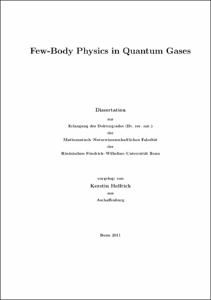Helfrich, Kerstin: Few-Body Physics in Quantum Gases. - Bonn, 2011. - Dissertation, Rheinische Friedrich-Wilhelms-Universität Bonn.
Online-Ausgabe in bonndoc: https://nbn-resolving.org/urn:nbn:de:hbz:5N-26767
Online-Ausgabe in bonndoc: https://nbn-resolving.org/urn:nbn:de:hbz:5N-26767
@phdthesis{handle:20.500.11811/5049,
urn: https://nbn-resolving.org/urn:nbn:de:hbz:5N-26767,
author = {{Kerstin Helfrich}},
title = {Few-Body Physics in Quantum Gases},
school = {Rheinische Friedrich-Wilhelms-Universität Bonn},
year = 2011,
month = oct,
note = {Few-body effects play an important role for the understanding of ultracold quantum gases. We make use of an effective field theory approach to investigate various aspects of universal few-body physics close to a Feshbach resonance. That is the regime where the scattering length is large compared to all other length scales of the system and thus determines the observables. It is also the regime where the Efimov effect whose main characteristic is the occurrence of a sequence of three-body bound states becomes important. At unitarity, i.e., for diverging scattering length, the ratio of binding energies of neighboring states approaches a constant. The existence of those trimers can be captured by a single three-body parameter and influences observables such as recombination rates.
Starting from adequate Lagrangians, we derive atom-dimer scattering amplitudes that contain all information of interest about the three-particle systems. With this method, we first investigate the scattering of atoms and dimers at finite temperature in the presence of the Efimov effect. We calculate the dimer relaxation rate and obtain good agreement with available experimental data. Furthermore, heteronuclear mixtures exhibiting large interspecies scattering length are studied in detail. If bosons are the majority species, the Efimov effect occurs in an S-wave channel and we are able to compute three-body recombination and dimer relaxation rates. The results are compared to the outcome of two existing experiments. For mainly fermionic systems, the Efimov effect is only present in an overall P-wave and three-body recombination at threshold vanishes. However, in mixtures of atoms and dimers, scattering cross sections and dimer relaxation show the typical Efimov behavior of log-periodicity. We also consider two-dimensional Bose gases, where the Efimov effect does not occur. For those systems, we derive an equation including the first non-universal corrections and deduce three-body observables such as binding energies and atom-dimer scattering parameters.},
url = {https://hdl.handle.net/20.500.11811/5049}
}
urn: https://nbn-resolving.org/urn:nbn:de:hbz:5N-26767,
author = {{Kerstin Helfrich}},
title = {Few-Body Physics in Quantum Gases},
school = {Rheinische Friedrich-Wilhelms-Universität Bonn},
year = 2011,
month = oct,
note = {Few-body effects play an important role for the understanding of ultracold quantum gases. We make use of an effective field theory approach to investigate various aspects of universal few-body physics close to a Feshbach resonance. That is the regime where the scattering length is large compared to all other length scales of the system and thus determines the observables. It is also the regime where the Efimov effect whose main characteristic is the occurrence of a sequence of three-body bound states becomes important. At unitarity, i.e., for diverging scattering length, the ratio of binding energies of neighboring states approaches a constant. The existence of those trimers can be captured by a single three-body parameter and influences observables such as recombination rates.
Starting from adequate Lagrangians, we derive atom-dimer scattering amplitudes that contain all information of interest about the three-particle systems. With this method, we first investigate the scattering of atoms and dimers at finite temperature in the presence of the Efimov effect. We calculate the dimer relaxation rate and obtain good agreement with available experimental data. Furthermore, heteronuclear mixtures exhibiting large interspecies scattering length are studied in detail. If bosons are the majority species, the Efimov effect occurs in an S-wave channel and we are able to compute three-body recombination and dimer relaxation rates. The results are compared to the outcome of two existing experiments. For mainly fermionic systems, the Efimov effect is only present in an overall P-wave and three-body recombination at threshold vanishes. However, in mixtures of atoms and dimers, scattering cross sections and dimer relaxation show the typical Efimov behavior of log-periodicity. We also consider two-dimensional Bose gases, where the Efimov effect does not occur. For those systems, we derive an equation including the first non-universal corrections and deduce three-body observables such as binding energies and atom-dimer scattering parameters.},
url = {https://hdl.handle.net/20.500.11811/5049}
}






